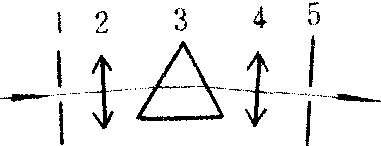单色仪dansheyi
以出射狭缝代替探测部件的分光计。是研究单色辐射的一种光谱仪器,由入射准直管,色散系统和出射准直管组成。在出射准直管透镜焦面上放置一个出射狭缝5(如图示),分出光谱中每一个单色成分。严格地说,是分出一个很窄波段的准单色光。转动色散系统3(棱镜或光栅)使光谱沿色散方向移动,就可依次获得各波段的单色光,供研究或应用。图中1为入射狭缝。(有时也可以利用滤光器得到准单色光,B.利奥在本世纪30年代首先使用这种方法)。

| 词条 | 单色仪 |
| 类别 | 中文百科知识 |
| 释义 | 单色仪dansheyi以出射狭缝代替探测部件的分光计。是研究单色辐射的一种光谱仪器,由入射准直管,色散系统和出射准直管组成。在出射准直管透镜焦面上放置一个出射狭缝5(如图示),分出光谱中每一个单色成分。严格地说,是分出一个很窄波段的准单色光。转动色散系统3(棱镜或光栅)使光谱沿色散方向移动,就可依次获得各波段的单色光,供研究或应用。图中1为入射狭缝。(有时也可以利用滤光器得到准单色光,B.利奥在本世纪30年代首先使用这种方法)。
|
| 随便看 |
开放百科全书收录579518条英语、德语、日语等多语种百科知识,基本涵盖了大多数领域的百科知识,是一部内容自由、开放的电子版国际百科全书。